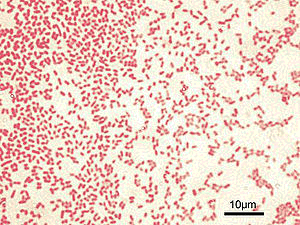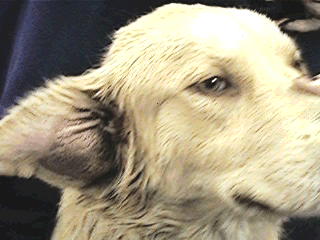Date Published: 06/27/2017
Date Reviewed/Revised: 10/15/2020


The Gram negative ear infection is a special situation because Gram negative bacteria (so named because they do not take up Gram stain when viewed under the microscope), tend to have unpredictable antibiotic profiles. This means we cannot simply pick a general ear product off the shelf; we will need to culture what is in the ear in order to get the right antibiotic. Worse still, Gram negative bacteria are especially talented at changing their antibiotic sensitivity so every time we guess wrong on the antibiotic, Gram negative bacteria become resistant to multiple additional antibiotics. This is how the superbugs we periodically read about in the news come to be.
It isn’t long before the pet is seen scratching at his ears, shaking his head or holding one ear slightly dropped. Discharge and odor may be noticeable to the owner.
More on on Pseudomonas Infection
Gram negative rods appear pink after Gram staining and, as mentioned, they tend to be more resistant to antibiotics than Gram positive (blue-staining) bacteria. A particularly heinous bacterial species is almost always resistant to most conventional antibiotics from the beginning, and it deserves special mention: Pseudomonas aeruginosa. When ear cytology samples reveal a Gram negative infection, culture is recommended as treatment for Pseudomonas but must be definitive. Pseudomonas should be identified as soon as possible.
You might wonder how such a difficult bacterium comes to be in a given ear. Sometimes a dog is just unlucky but often Pseudomonas infection happens in ears that have been treated repeatedly for ear infections in the past. The unfortunate tendency is for normal ear bacteria to be killed off with each treatment course leaving only the most resistant bacteria to colonize the ear canal. Pseudomonas readily grows and prospers where less resistant bacteria have been cleared.
If you are lucky, a culture of the discharge will reveal that the Pseudomonas is still sensitive to a quinolone antibiotics such as enrofloxacin, marbofloxacin, or orbifloxacin. It should be noted that especially high doses of this type of antibiotic are needed to treat Pseudomonas in the ear and that inadequate dosing will just make Pseudomonas even more resistant. Therapy must be decisive.
If you are not as lucky, the culture may show there are no effective oral antibiotics or possibly no antibiotics at all that will be effective. In this situation, disinfectant rinses may be the only choice.
Oral therapy (pills), if culture indicates it is likely to work, is generally combined with some kind of topical treatment. This may involve a commercial product, combination of products, or even a concoction your veterinarian mixes up.
Complications of Gram Negative Ear Infection
Aural Hematoma
When a dog with uncomfortable ears shakes and scratches vigorously, a blood vessel in the earflap may rupture. This leads to bleeding into the tissues of the pinna (see above illustration). The usual recommendation is to have the blood clots removed and the ear bandaged and cleaned under anesthesia. If the hematoma is not so big as to occlude the ear canal (thus preventing medication of the ear canal), the option to forgo surgery exists; but without surgery, the ear may scar down into an abnormal appearance.

Middle Ear Infection
A routine ear infection is uncomfortable enough but if the infection persists, it can become an even bigger problem. The infection can lead to proliferation and scarring in the canal which makes the infection especially difficult (and potentially impossible) to clear up. The ear canal may mineralize and the middle ear may come to be involved, leading to nerve damage. Affected animals may have a head tilt, a lack of balance, and unusual back-and-forth eye movements (called nystagmus.) These symptoms are called vestibular signs and are a complication of middle ear infection. Middle ear infections can also cause paralysis of the facial nerve, leading to a slack-jawed appearance on that side of the face.
Severe cases may require surgical intervention to remove the vertical portion of the ear canal (lateral ear resection) or even remove and seal the ear canal (ear canal ablation). It is important to control ear infections before they reach this stage if at all possible.
Treatment
Level One: The Simple Ear Infections
Most ear infections are cleared up simply with professional cleaning followed by medication at home. If only mild debris is present in the ear canals, simple disinfection and washing of the ear is adequate; however, in many cases, a full ear flush is needed to even examine the eardrum. For patient comfort, we recommend sedation for this procedure as the ears are sore and the instruments can be damaging if the pet jumps at the wrong time. A sample of ear discharge is commonly examined under the microscope so as to assist in selecting medications for home use. After a couple of weeks of home treatment, the ear canals are rechecked to be sure the infection is gone. In most cases this completes treatment but for stubborn cases, we must proceed to the next step.
Level Two: On-Going Ear Infections
Some dogs have chronic ear problems (the infection is not controlled by general medication or returns when general medication is discontinued). In these cases, the ear discharge should be cultured so that the precise organism can be pinpointed and treated specifically. Regular treatment at home with disinfecting ear washes should become part of the pet's grooming routine.
Further testing may be in order to determine why the infection continues to recur. Allergy is the most common reason for recurrent ear problems but hormone imbalances can also be underlying causes.
Level Three: The End-Stage Ear
Some ear infections simply cannot be controlled with the above steps. These cases have transcended medical management and must proceed to surgical management. What this entails will depend on the state of the ear canal. Your veterinarian will make recommendations accordingly.
Ear infections are common and can be challenging. Fortunately, most cases are simple and easily cleared up. Be sure to recheck the ears as your veterinarian recommends as premature discontinuance of treatment can lead to a continuing infection.
Gram negative ear infections do not have the same kind of leeway that other ear infections do. It is crucial that recheck appointments are not skipped because Gram negatives will simply get harder to clear if treatment is incomplete. Your veterinarian will need to confirm that the infection is resolved fully before medication can be withdrawn.





